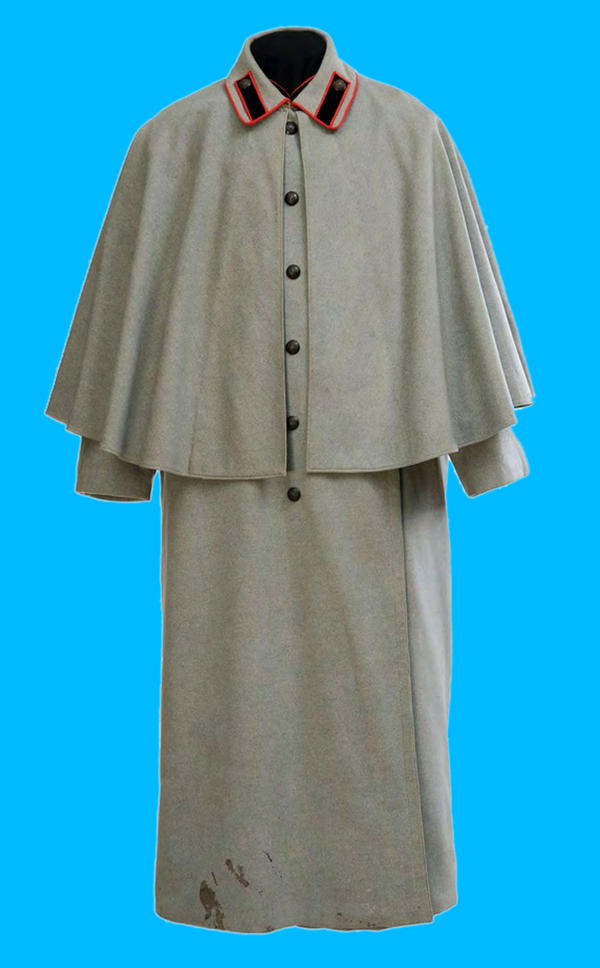In the exhibition hall at the Saratov Regional Museum, there is a military overcoat that covered Pyotr Arkadyevich Stolypin, the prominent Russian statesman, after he was wounded. The overcoat with a cape is made of light gray cloth; and silk was used for the lining. Black tabs with red edges are sewn onto the collar. On the overcoat there are buttons with coats of arms buttons that depict the image of a two-headed eagle.
On September 1st, 1911 Pyotr Stolypin attended a performance of The Tale of Tsar Saltan at the Ukrainian National Opera House. Dmitriy Bogrov, a former agent with the Kiev branch of the Department for Protecting Public Security and Order, and who had become a group of Kiev-based adherents of anarchist communism, fatally wounded Pyotr Stolypin during the intermission. On the way to the Mayakovskiy Hospital, the wounded man was covered with the overcoat that is now at the museum. The overcoat’s right hem has traces of blood on the inside that belong to Stolypin. On September 5th, Stolypin died from his wounds.
From 1903-1906, Pyotr Arkadyevich held the post of governor of Saratov. During that time, he accomplished much for Saratov. During the years when he was the governor, ground was broken for the Mariinsky Women’s Preparatory School, construction work began on a veterinary and bacteriology center, the city’s telephone network was upgraded, and work began to pave Nikolskaya Street and Aleksandrovskaya Street. Thanks to Stolypin, Saratov received funding to build a water main and streetways. Outdoor electrical lighting was installed around the city. When in the post of Chairman of the Council of Ministers, Pyotr Stolypin contributed to opening a university in Saratov, and for this he was awarded the title of Honorary Citizen of Saratov.
After Stolypin’s death, at the initiative of the Saratov Scientific Archive Commission, a museum was created in his memory that existed for five years. That museum’s exhibits included this overcoat that is on display, and which was donated to the museum by Stolypin’s widow, Olga Borisovna. In the inventory records for the Stolypin Museum, this exhibit is listed as ‘a military overcoat under the cover of which the Chairman of the Council of Ministers was brought to the privately run Mayakovskiy Hospital’. Stolypin’s overcoat only arrived at the Saratov Regional Museum in 1939.
On September 1st, 1911 Pyotr Stolypin attended a performance of The Tale of Tsar Saltan at the Ukrainian National Opera House. Dmitriy Bogrov, a former agent with the Kiev branch of the Department for Protecting Public Security and Order, and who had become a group of Kiev-based adherents of anarchist communism, fatally wounded Pyotr Stolypin during the intermission. On the way to the Mayakovskiy Hospital, the wounded man was covered with the overcoat that is now at the museum. The overcoat’s right hem has traces of blood on the inside that belong to Stolypin. On September 5th, Stolypin died from his wounds.
From 1903-1906, Pyotr Arkadyevich held the post of governor of Saratov. During that time, he accomplished much for Saratov. During the years when he was the governor, ground was broken for the Mariinsky Women’s Preparatory School, construction work began on a veterinary and bacteriology center, the city’s telephone network was upgraded, and work began to pave Nikolskaya Street and Aleksandrovskaya Street. Thanks to Stolypin, Saratov received funding to build a water main and streetways. Outdoor electrical lighting was installed around the city. When in the post of Chairman of the Council of Ministers, Pyotr Stolypin contributed to opening a university in Saratov, and for this he was awarded the title of Honorary Citizen of Saratov.
After Stolypin’s death, at the initiative of the Saratov Scientific Archive Commission, a museum was created in his memory that existed for five years. That museum’s exhibits included this overcoat that is on display, and which was donated to the museum by Stolypin’s widow, Olga Borisovna. In the inventory records for the Stolypin Museum, this exhibit is listed as ‘a military overcoat under the cover of which the Chairman of the Council of Ministers was brought to the privately run Mayakovskiy Hospital’. Stolypin’s overcoat only arrived at the Saratov Regional Museum in 1939.



